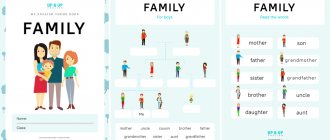Abstract header
A lesson plan always starts with a cap. It states:
- Lesson topic. Often it is written down in the teacher’s lesson plan.
- Target. Each lesson has its own triune goal. It includes: training (for example, to give an idea of the subject, summarize and systematize knowledge, practice skills); development (develop memory, thinking, communication skills, ability to work independently); education (to foster or instill a sense of patriotism, hard work, discipline, etc.).
- Tasks that state the minimum knowledge and skills that students must acquire during the lesson. They are required to meet the knowledge requirements that the Ministry of Education sets for students.
- Lesson type.
- Methods and techniques used in the lesson: exercise method, lecture, conversation, microphone, dictation and others.
- Equipment used in the lesson: video and audio materials, pictures, presentations, cards.
- Literature. It is also advisable to indicate the sources that were used in compiling the lesson - articles, textbooks.
Components of the plan
Any lesson plan consists of the following sections:
- The header of the summary, which contains basic information about the lesson, its type and type, goals, objectives.
- The course of the lesson is the main part of the outline, in which each action of the teacher is written out step by step, starting from the organizational moment and ending with summing up or reflection.
- Homework. It may be absent if this was a control lesson.
Next we will look at each of these points in more detail.
Choosing a lesson form
The form of the lesson is fertile ground for your imagination. Depending on the type of lesson (presenting new material, monitoring student knowledge, etc.), think about what your students would like. Perhaps they will be happy to travel to the places of life and work of the author being studied, or will they want to take part in an intellectual game? You can invite children to evaluate the work of their classmates (but the teacher should have the final say) or create the conditions for a successful discussion by dividing the class into groups defending different views.
If you decide to try a non-standard lesson format, you need to think carefully about where problems might arise in your plan. Prepare for the unexpected, develop several options in case the lesson does not go according to plan and the students and the committee get bored. When choosing a lesson form, you should focus on a specific class. After all, not all children will accept your rules of the game. And if they don’t want to participate in your experiments, failure is guaranteed. It is advisable to try out innovations in another class before the start of a planned open lesson. This way you can identify weak points in your plan and look at the students’ reactions.
Remember the main stages of the lesson that need to be played out in accordance with the form of the lesson. The Commission usually closely monitors compliance with this condition.
Outline of an open lesson
Outline of an open lesson
additional education teacher
Mukhina Inna Petrovna
creative association “Making Together”
Lesson topic:
“Techniques for working with paper: torsion. Making a card for Mother's Day"
Target
: strengthening paper handling skills.
Tasks:
familiarization with the technique of processing paper “torsion”,
the formation of imaginative thinking, the ability to reproduce the design of simple objects,
development of the eye,
education of neatness and aesthetic taste.
formation of sensitivity, responsiveness, good attitude towards mother.
Form of work
: group
Teaching methods:
explanatory and illustrative method, activity method
Equipment:
sample of the finished work, colored and white paper with marked decorative elements, glue, scissors, pencils.
Progress of the lesson
Organizational part.
Greeting the teacher, announcing the topic of the lesson, preparing the workplace
Introductory part.
Today in class we will make a card for mothers. On the last Sunday of November, our country celebrates a wonderful holiday - Mother's Day; on this day it is customary to congratulate mothers and grandmothers. For every person, mother is the most important person in life.
The best gift for mothers is one that is made with their own hands. Now each of you will make a postcard, sign it and give it to your mother. Try to work carefully, because your mothers deserve the best!
Practical part
The postcard consists of both a base and decorative elements. First, let's prepare the base, give the rectangular blank a more interesting shape, cutting off the edges along the outlined lines. But before we start working with scissors, let’s repeat the rules for working with them (students’ answers)
Let's cut out decorative elements: two flowers of different sizes and shapes, as well as a circle for the center of the flower. Cut slowly, trying to cut exactly along the lines. After all, whether your work will turn out beautiful depends on how carefully you work.
In class we learned about different ways of processing paper: bending, folding, cutting, gluing. Today, when making a postcard, we will use another method - torsion. Let's give the flower petals a rounded shape by twisting each petal onto a pencil.
Now you can glue the flowers to the base: first a large flower, then a small one. First, without glue, place the flower on the base, finding the best option, then apply glue only to the center of the flower and glue it. Glue the second flower, placing the petals in the spaces of the first, then glue the middle circle.
Wrap the paper strips tightly around a pencil, giving them a spiral shape. For a postcard, it is enough to make 3-5 such spirals. Glue them to the base, hiding one end under the petals, and securing the other outside the flower.
Conclusion
The postcard is ready, well done to all of you! I see they tried very hard. Let's put things in order on the table. Now we just have to remember the affectionate words we call moms. (they call it in turn: “kind”, “beloved”...)
Or maybe someone knows poems about mothers?
Mom is a gentle smile, Mom is the sun from heaven, Mom is a bright angel, The best of all miracles.
Mom - warm palms, Mom - eyes of kindness, In this world, you are the most beautiful of all, Mom, you are the most loved of all!
Today is the kindest day, Today all the attention goes to mothers, And we are not too lazy to congratulate you, You are all worthy of adoration!
No one can love as much as a dear mother. We wish you all to live in happiness, meeting no sorrows along the way!
I think you found it interesting. Don't forget to congratulate your beloved mothers on Mother's Day! Goodbye children!
Homework
Homework is written down at the end of the notes. Often it involves working with a textbook and doing certain exercises.
If you already have a lesson plan for the next lesson, you can have students process the material you have prepared for study and then share it with their classmates.
Alternatively, the teacher can offer differentiated homework for the students to choose from. For example, do exercises from the textbook or create a project on the topic - reference tables, tests, wall newspapers, select exercises for consolidation. Naturally, creative tasks are assessed separately. Students who claim high grades can complete them.
Analysis of an open lesson
After the lesson, there must be a debriefing. First, a self-analysis of the teacher conducting an open lesson. He voices the extent to which the goals and objectives have been achieved, explains any deviations in the plan, comments on the grades given and the necessary nuances.
This is followed by an analysis of the open lesson by the school administration (head teacher, director), the chairman of the methodological association or the subject methodologist. If time permits, you can have a small discussion with questions and recommendations.
Important little things
- If you have chosen the traditional form of a lesson, you should not neglect small effective moves, a highlight that will make your lesson memorable. Some teachers look for interesting aphorisms or parables that smoothly lead the conversation to the topic of the lesson. Remember about visual aids, but it is important not to overdo it in this matter - in this case, students will remember them, and the information you provide will fall on deaf ears.
- It would be a good idea to prepare a booklet in advance for presenting your lesson to the assessors. Firstly, it will be more convenient for them to monitor the progress of your work, and, secondly, this simple trick allows you to win over the commission by showing your respect for their work.
- To conduct an open lesson perfectly, you need the right attitude – yours and the class’s. The commission expects to see a teacher who is calm, confident in himself and his students. Your task is to conduct the lesson as if there were no committee in the room at all. Explain to children that the assessors are not in the classroom to evaluate their knowledge and their presence will not affect their performance in any way.
- Refrain from rehearsing with a class that is planning an open lesson. An experienced eye will always distinguish a rehearsed lesson from the unnatural behavior of children and the teacher. In addition to the negative opinion of the commission about your work, such attempts entail a loss of teacher authority among students. Don't try "too hard." The inspectors will leave, and the children will respect you much less for this suspicious and unnatural zeal.
- Before the end of the lesson, you should sum up, summarize the work of the class, and discuss future plans.
- After the lesson, you will be required to self-reflect on the lesson. It is advisable to prepare it in advance - approximate, of course. This will help you not to be lost in words, to know what you need to start from when evaluating your work.
How to conduct an open lesson correctly
Since an open lesson forces teachers and students to be in a state of heightened emotional and psychological stress, you need to use some tips to help you withstand this test with dignity.
Adviсe:
- Before the lesson, give yourself the mindset that everything will work out;
- be natural in communicating with children, i.e. the way they are used to seeing their teacher;
- do not show your excitement, then the children will work calmly;
- support students during oral questioning and do not criticize them for incorrect assumptions;
- Keep the lesson plan in front of you so that you can refer to it at the right time.
Conducting an open lesson
- Start of the lesson. For any activity, the organizational aspect is very important. It begins with establishing proper order in the classroom and greeting students. Next, you should take a roll call and mark those who are absent.
- In the classic version of the lesson, after this you need to start checking your homework. For an open lesson, an oral survey is preferable, since in this case the “spectators” will be able to find out what material was covered and how the students learned it.
- New material. An open lesson involves actions according to a plan, so in this part it will be necessary to announce to students not only a new topic, but also the goals and objectives of the lesson (in regular lessons this is not always brought to the attention of students). The explanation of new material should demonstrate the teacher's pedagogical skills, his knowledge of scientific information and his ability to communicate with children. You should not turn the explanation of a new topic into a monologue. It is advisable to contact students with questions more often, to maintain their activity and attention.
- Reinforcement of the material can be done through a quick survey. This will allow you to immediately understand how well the students have mastered the topic and what they should pay attention to in the future.
- Ending. At this stage, the results are summed up and homework is given. An important point: children must be released from the lesson with a bell, without being detained.
Main stages of an open lesson
Every teacher knows the main stages of conducting a classic lesson:
- Organizing time.
- Checking homework.
- New material.
- Consolidation.
- Homework.
- Summing up the lesson.
Since conducting any lesson means working with children, whom you need to focus on first of all, in practice, the sequence of stages has to be swapped from time to time or completely depart from the traditional version.
To conduct an open lesson, you will need this plan or several points from it (depending on what type of lesson was chosen).




